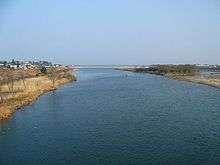Hino River
| Hino River | |
|---|---|
 Hino River near Yonago, Tottori Prefecture | |
| Country | Japan |
| Basin | |
| Main source |
Mount Mikuni and Mount Dōgo, Tottori Prefecture 1,004 metres (3,294 ft) |
| River mouth |
Miho Bay, Sea of Japan 0 m (0 ft) |
| Basin size | 870 square kilometres (340 sq mi) |
| Physical characteristics | |
| Length | 77 kilometres (48 mi) |
The Hino River (日野川 Hino-gawa) is a major river in the western part of Tottori Prefecture. The river flows east-northeast for 77 kilometres (48 mi), and is the longest river in the prefecture. The Hino River emerges from the Chūgoku Mountains. The source of the river is at an elevation of 1,004 metres (3,294 ft) in an area near Mount Mikuni and Mount Dōgo in Nichinan in southeastern Tottori Prefecture.[1] At Kofu, the river turns north-northwest. The lower part of the Hino River flows through the Yonago Plain[2] before finally discharging into Miho Bay at Hiezu near Yonago. Erosion over time has created the scenic Sekkakei Ravine. The Sukesawa Dam forms an artificial lake, Lake Nichinan.[1] Approximately 60,800 people use the water provided by the Hino River.
Tributaries
- Inga River (印賀川 Inga-gawa) - 25.8 kilometres (16.0 mi)[1][3]
- Hosshōji River (法勝寺川 Hosshōji-gawa) - 23.5 kilometres (14.6 mi)[4]
References
- 1 2 3 "日野川 (Hino-gawa)". Nihon Daihyakka Zensho (Nipponika) (日本大百科全書(ニッポニカ) (in Japanese). Tokyo: Shogakukan. 2012. Archived from the original on August 25, 2007. Retrieved 2012-04-21.
- ↑ "日野川 (Hino-gawa)". Dijitaru daijisen (in Japanese). Tokyo: Shogakukan. 2012. Archived from the original on August 25, 2007. Retrieved 2012-04-21.
- ↑ "Inga-gawa (印賀川)". Nihon Rekishi Chimei Taikei (日本歴史地名大系) (in Japanese). Tokyo: Shogakukan. 2012. Archived from the original on August 25, 2007. Retrieved 2012-04-10.
- ↑ "Hosshōji-gawa (法勝寺川)". Nihon Rekishi Chimei Taikei (日本歴史地名大系) (in Japanese). Tokyo: Shogakukan. 2012. Archived from the original on August 25, 2007. Retrieved 2012-04-10.